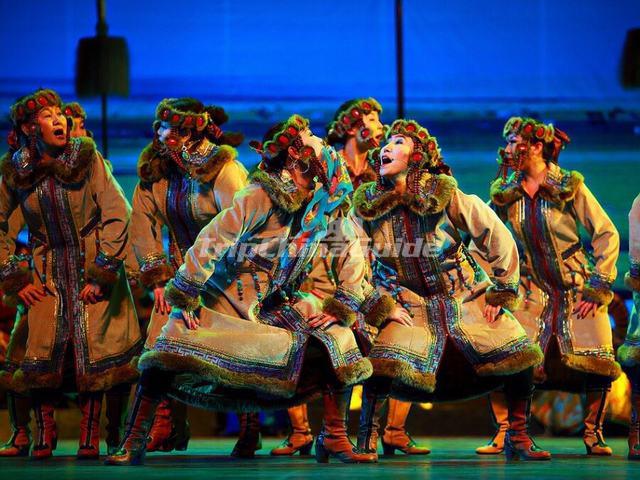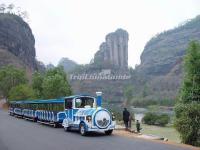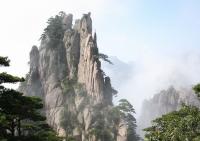Ewenki Ethnic Group
The Ewenki people are one of the ancient nationalities and one of the 56 ethnic groups officially recognized by the People's Republic of China. Ewenki is the self-denomination of the nationality, which means "people who live in the mountain forest".
Population
30,875 (2010)
Main Areas Inhabited by Ewenki
This ethnic minority is distributed across seven banners (counties) in the Inner Mongolia Autonomous Region and in Nahe County of Heilongjiang Province, where they live together with Mongolians, Daurs, Hans and Oroqens.
Language
The Ewenki people have no written script but a spoken language composed of three dialects belonging to the Manchu-Tungusic group of the Altai language family. Mongolian is spoken in the pastoral areas while the Han language is used in agricultural regions.
Terrain and Resources
The Ewenki Autonomous Banner, nestled in the ranges of the Greater Hinggan Mountains, is where the Ewenki people live in compact communities. A total of 19,110 square kilometers in area, it is studded with more than 600 small and big lakes and 11 springs. The pastureland here totaling 9,200 square kilometers is watered by the Yimin and four other rivers, all rising in the Greater Hinggan Mountains.
Nantunzhen, the seat of the banner government, is a rising city on the grassland. A communication hub, it is the political, economic and cultural center of the Ewenki Autonomous Banner.
Large numbers of livestock and great quantities of knitting wool, milk, wool-tops and casings are produced in the banner. Some 20-odd of these products are exported. The yellow oxen bred on the grassland have won a name for themselves in Southeast Asian countries. Pelts of a score or so of fur-bearing animals are also produced locally.
Reeds are in riot growth and in great abundance along the Huihe River in the banner. Some 35,000 tons are used annually for making paper. Lying beneath the grassland are rich deposits of coal, iron, gold, copper and rock crystal.
History
The forefathers of the Ewenkis had originally been a people who earned their living by fishing, hunting and breeding reindeer in the forests northeast of Lake Baikal and along the Shileke River (upper reaches of the Heilong River), tracing their ancestry to the "Shiweis", particularly the "Northern Shiweis" and "Bo Shiweis" living at the time of Northern Wei (386-534) on the upper reaches of the Heilong River, and the "Ju" tribes that bred deer at the time of the Tang Dynasty (618-907) in the forests of Taiyuan to the northeast of Lake Baikal. Later, they moved east, with one section coming to live on the middle reaches of the Heilong River. In history, the Ewenkis and the Oroqens and Mongolians living in forests to the east of Lake Baikal and the Heilong River Valley in the Yuan Dynasty (1280-1368) were known as a "forest people," and a people "moving on deer's backs" by the time of the Ming (1368-1644). When it came to the Qing period (1644-1911) they were called the "Sulongs" or "Kemunikans" (another tribal people different from the Sulongs at the time) who knew how to use deer.
In 1635, the Kemunikans came under the domination of Manchu rulers after their conquest of the Lake Baikal area, to be followed around the years from 1639 to 1640 by their control of the Sulongs living to the east of Lake Baikal. From the mid-17th century onwards, aggression by Tsarist Russia had led the Qing government to remove the Ewenkis to the area along the Ganhe, Nuomin, Ahlun, Jiqin, Yalu and Namoer -- tributaries of the Nenjiang River. In 1732, 1,600 Ewenkis were called up in the Buteha area and ordered together with their family dependents to perform garrison duties as frontier guards on the Hulunbuir Grassland. Their descendants are now the inhabitants of the Ewenki Autonomous Banner.
Life Style
Immigrations in the past led to population dispersion which in turn resulted in great unevenness in the social development of the Ewenki people dwelling in different places with diverse natural conditions. As a result, some Ewenki people are nomads; others are farmers or farmer-hunters. A small number of them are hunters.
The Ewenkis in the Ewenki Autonomous Banner and the Chenbaerfu Banner lead a nomadic life, wandering with their herds from place to place in search of grass and water. They live in yurts.
The Ewenki people excel in horsemanship. Boys and girls learn to ride on horseback at six or seven when they go out to pasture cattle with their parents. Girls are taught to milk cows and take part in horseracing at around ten, and learn the difficult art of lassoing horses when they grow a little older.
A "Mikuole" festival is traditionally observed by Ewenki herdsmen in May every year. At happy gatherings held everywhere on the grasslands, men, women and children in their holiday best go from yurt to yurt to partake wine, fine foods and other delicacies prepared for the occasion. It is a time for nomads to count new-born lambs and take stock of their wealth, and for young, sturdy lads to demonstrate their skills in lassoing horses and branding or castrating them.
With the institution of the "eight banner system" way back in the 17th century, Ewenki nomads were drafted into the army and had the obligation to pay leopard skins as tributes to the Qing rulers. This was at a time when they were at the transitional stage from primitivity to a class society. Helped by the Qing rulers, an upper stratum of Ewenkis invested with feudal rights then emerged. The expansion of agriculture and animal husbandry finally brought the Ewenki nomads to the threshold of a patriarchal feudal society.
A "nimoer" mutual-aid group consisting of a few to 10-odd families was usually formed by the Ewenkis to pasture their herds. People in the group were members of the same clan, and there was no exploitation of man by man at first. But in later years each "nimoer" group came to be dominated by a feudal lord, who had far more cattle than the other nomads in the group. In name the pastures belonged to the "nimoer" group, but in fact it was owned by the feudal chief who had the biggest herd. The poor nomads in the "nimoer" were at the beck and call of the feudal chief for whom they had to perform corvee.
A concentration of land also took place in areas where the Ewenkis lived as farmers or farmer-hunters. In areas near mountains, they lived by hunting, lumbering and making charcoal, with a few going in for farming. There emerged landlords, some possessing as many as 300 hectares of land. Here poor Ewenkis became employed hunters of landlords who supplied guns, ammunition and hunting horses and took away the bulk of the game bagged.
In the forests of the Ergunazuo Banner were Ewenki hunters who, having no permanent homes, wandered from place to place with their reindeer in search of game. When they stopped in the hunt, these Ewenki hunters lived in make-shift, umbrella-shaped tents built on 25 to 30 larch poles. In summer these tents were roofed over with birch bark, and in winter with reindeer hides. When the hunters were on the move, their tents and belongings as well as their capture were carried by reindeer, which lived on moss.
The roving Ewenki hunters were still in the last stage of the primitive society on the eve of liberation. Five or six to a dozen families who were very closely related were grouped under a clan commune, the chief of which was elected. All in the commune took part in hunting, and the game bagged was divided equally among the families. However, changes were already taking place in the clan commune system at the time of liberation when shot-guns, reindeer and the much-prized squirrel pelts were coming into the possession of individual families.
Folkway
The Ewenkis are an honest, warm-hearted and hospitable people. Guests in the pastoral areas are often treated to tobacco, milk tea and stewed meat by the Ewenki hosts. Such delicacies as reindeer meat, venison, elk-nose meat sausages are generously offered in the hunting areas. When Ewenki hunters go out on long hunting trips, they leave whatever they cannot take along -- foodstuffs, clothing and tools in unlocked stores in the forests. Other hunters, who are in want, may help themselves to the things stored without the permission of their owners. The things borrowed would be returned to the store owners when the hunters happen to meet them at any time in future.
Marriage
Monogamy is generally practiced. In old days exogamy was strictly observed. Members of the same clan were not permitted to marry one another, and those going against this unwritten law would be punished.
An Ewenki wedding is an occasion for dancing and merry-making. All Ewenki folk dances are simple and unconstrained. The dancers' foot movements, executed in a forceful and vigorous style and highly rhythmic, are characteristic of the honest, courage and optimistic traits of this ethnic minority.
Culture and Art
Myths, fables, ballads and riddles form their oral literature. Embroidery, carving and painting are among the traditional lines of modeling arts as commonly seen on utensils decorated with various floral designs. An adept hand is also shown by the Ewenkis at birch bark carving and cutting in producing all kinds of fancy beasts and animals as toys for children.
Religion
Most Ewenki people are animists while those in the pastoral areas are followers of the Lamaist faith. A few living in the Chenbaerhu area are believers of the Eastern Orthodox Church.
While believing in animism, Ewenki people also worship their dead ancestors, and lingering influences of bear worship is still found among Ewenki hunters. After killing a bear, the Ewenkis would conduct a series of rituals at which the bear's head, bones and entrails are bundled in birch bark or dry grass and hung on a tree to give the beast a "wind burial." The hunters weep and kowtow while making offerings of tobacco to the dead animal. In the Chenbaerhu area every clan has its own totem -- a swan or a duck -- as an object of veneration. People would toss milk into the air upon seeing a real swan or duck flying overhead. No killing of these birds is permitted.
Funeral
Wind burial was originally given to the dead. But it has now been replaced by burial in the ground, thanks to the influence of other ethnic groups living nearby, then and now.
Development of the Nationality and Life Today
Dispersed to live in different places and with many Ewenkis dragged into the army by the Qing rulers, the Ewenki ethnic group was threatened by extinction. Of a total number of 1,700 Ewenki troops sent to suppress a peasant army of other nationalities that rose against the Qing government in 1695, only some 300 survived the fighting. Following their occupation of northeast China in 1931, the Japanese imperialists not only intensified their exploitation of Ewenki people but drafted many of them into the Japanese army. They lured Ewenkis into the habit of opium-smoking and used some of them for bacteria experiments. All this, coupled with the spread of smallpox, typhoid fever and venereal diseases, brought about a sharp population decline. For example, there were upwards of 3,000 Ewenkis living along the Huihe River in 1931, but less than 1,000 remained in 1945.
Things took a turn for the better for this ethnic minority after the Japanese surrender in 1945. Two years later democratic reforms were carried out in both the pastoral and farming areas. As for Ewenki hunters roving in the forests, efforts were made to help them develop production and raise their cultural level. With the setting of cooperatives, these hunters will later leap the socialism. Socialist reforms in most of the Ewenki area were completed towards the end of 1958.
The Ewenki Autonomous Banner was established on August 1, 1958, in the Hulun Beir League (Prefecture). Five Ewenki townships and an Ewenki district were set up later. A large number of Ewenki people were trained for administrative work.
A series of measures, including the introduction of fine breeds of cattle, the opening of fodder farms, improved veterinary services, building permanent housing for roving nomads and the use of machinery, have been taken to boost livestock production in the Ewenki Autonomous Banner. In the forested areas, Ewenki hunters, who used to be on the move after their game, now live in permanent homes. They still hunt, but they have also gone in for other occupations.
In the old days almost all the Ewenki people were illiterate. Today more than 90 per cent of all school-age children are at school. Some Ewenki people have been enrolled in the Central Nationalities Institute in Beijing, Inner Mongolia University in Hohhot and other institutions of higher learning.
With improved health care, TB, VD and other diseases that used to plague the Ewenki people have been put under control. Hospitals, maternity and child care centers, TB and VD prevention clinics are now at the service of the Ewenkis who knew no modern medical care formerly. As a result the population in the banner, which had dwindled for a century or more, has increased by many folds in the past four decades. The Ewenki ethnic group which was dying out is freed from the threat of extinction.
Clothing
The Evenks wore a characteristic costume "adapted to the cold but rather dry climate of Central Siberia and to a life of mobility, they wore brief garments of soft reindeer or elk skin around their hips, along with leggings and moccasins, or else long supple boots reaching to the thigh". They also wore a deerskin coat that did not close in front but was instead covered with an apron-like cloth. Some Evenkis decorated their clothing with fringes or embroidery. The Evenki traditional costume always consisted of these elements: the loincloth made of animal hide, leggings, and boots of varying lengths. Facial tattooing was also very common.
Food
Ewenki people live in Pure animal husbandry production area eat milk, meat and noodles as the staple, they can't eat without milk tea in three meals. Ewenki people live in the primitive forest of northern greater hinggan mountains completely eat meat as the staple in daily life.
Building
The main housing is round "ger" in pastoral areas. While the people in the forest have no fixed homes, their traditional houses are "Cuo Luo Zi", actually is a conical shack made of pine, is a kind of very simple tent.
Festivals
There are many festivals in Ewenki people, such as Mi Kuo Lu Festival (mid to late May), Festival Aobao (late May to early June in lunar calendar), Se Bin Festival (on June 18), etc.
Taboos
1. Ewenki people have many taboos for fire, such as they cannot stab fire with sharp iron; cannot splash fire with water; cannot throw mess in fire; cannot stamp on the fire, women cannot walk across the fire, etc.
2. The Ewenki people worship the bear, if they kill the bear, they don’t say the bear dead, but say it falls in sleep.
3. Men cannot eat the bear’s palms and tail, or their guns will be taken away by the bears when they are hunting.
4. Any people are not allowed to eat the bear’s liver, lung, heart, brain and eyes. They are known as the places where the bear’s soul is hidden.
Recommended China Tour Packages
-
3-day Mount Wuyi Highlights Tour
-
10-day Yellow Mountain vs Zhangjiajie National Park Tour
-
3-day Jiuzhaigou Valley Tour



















